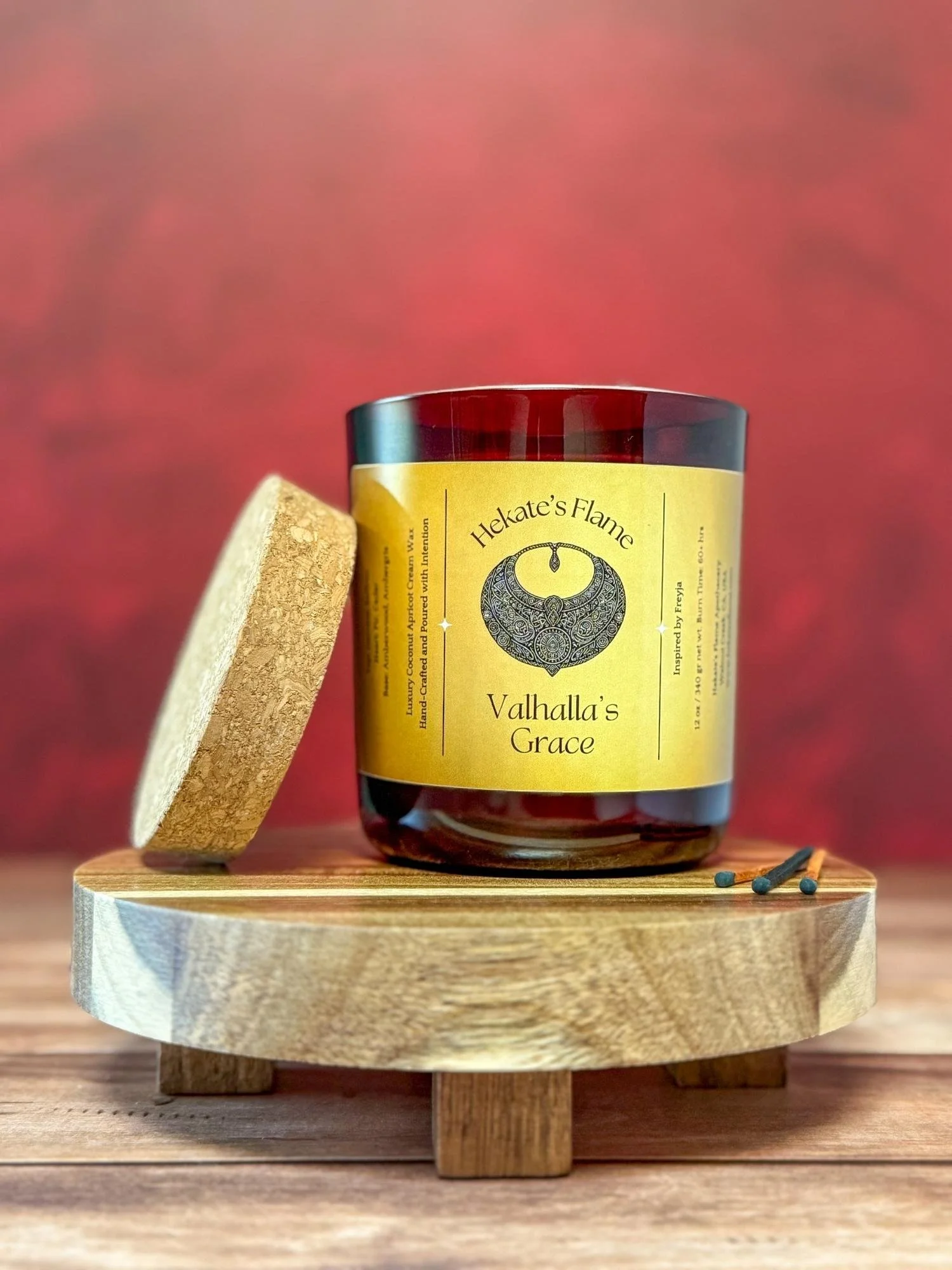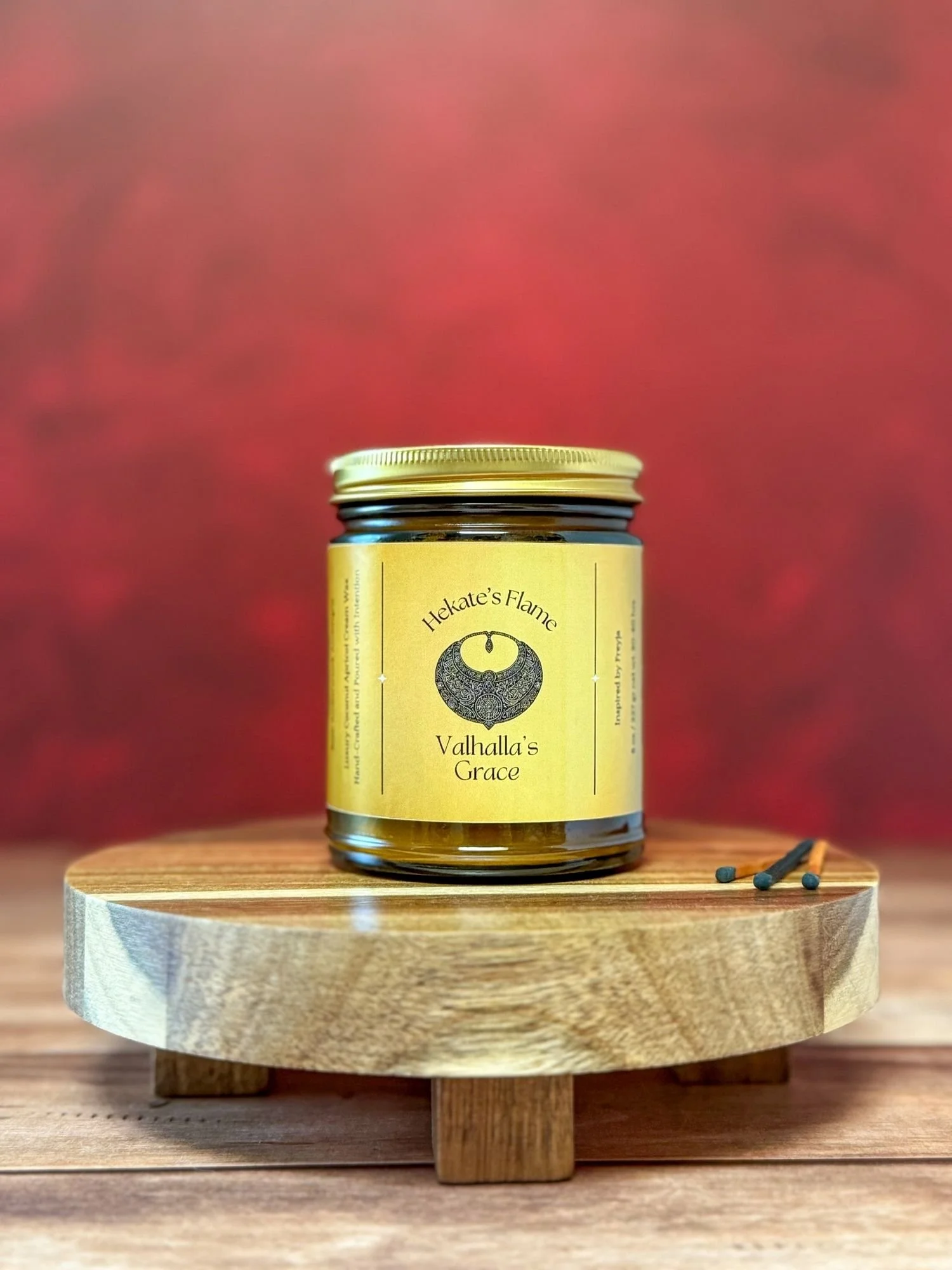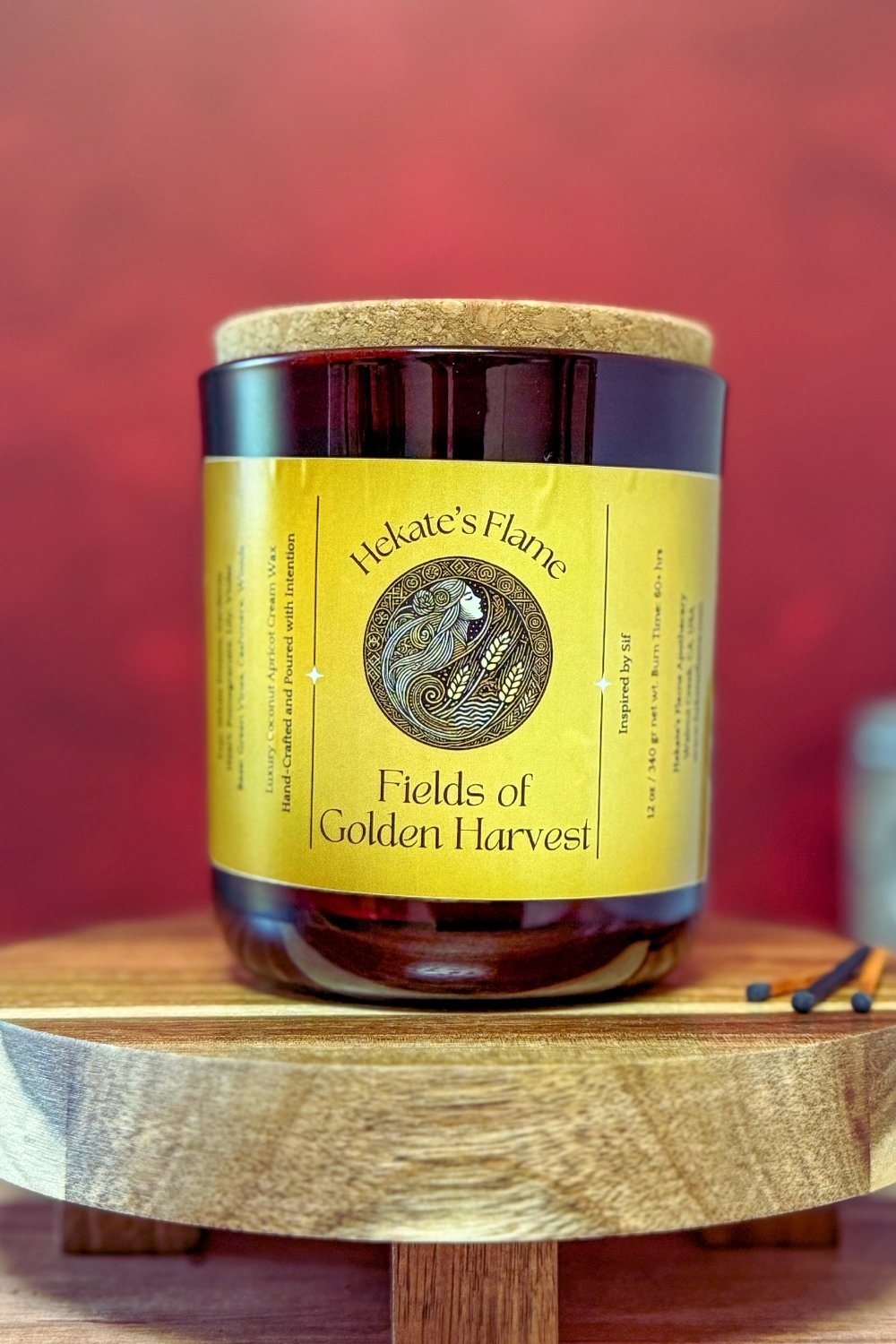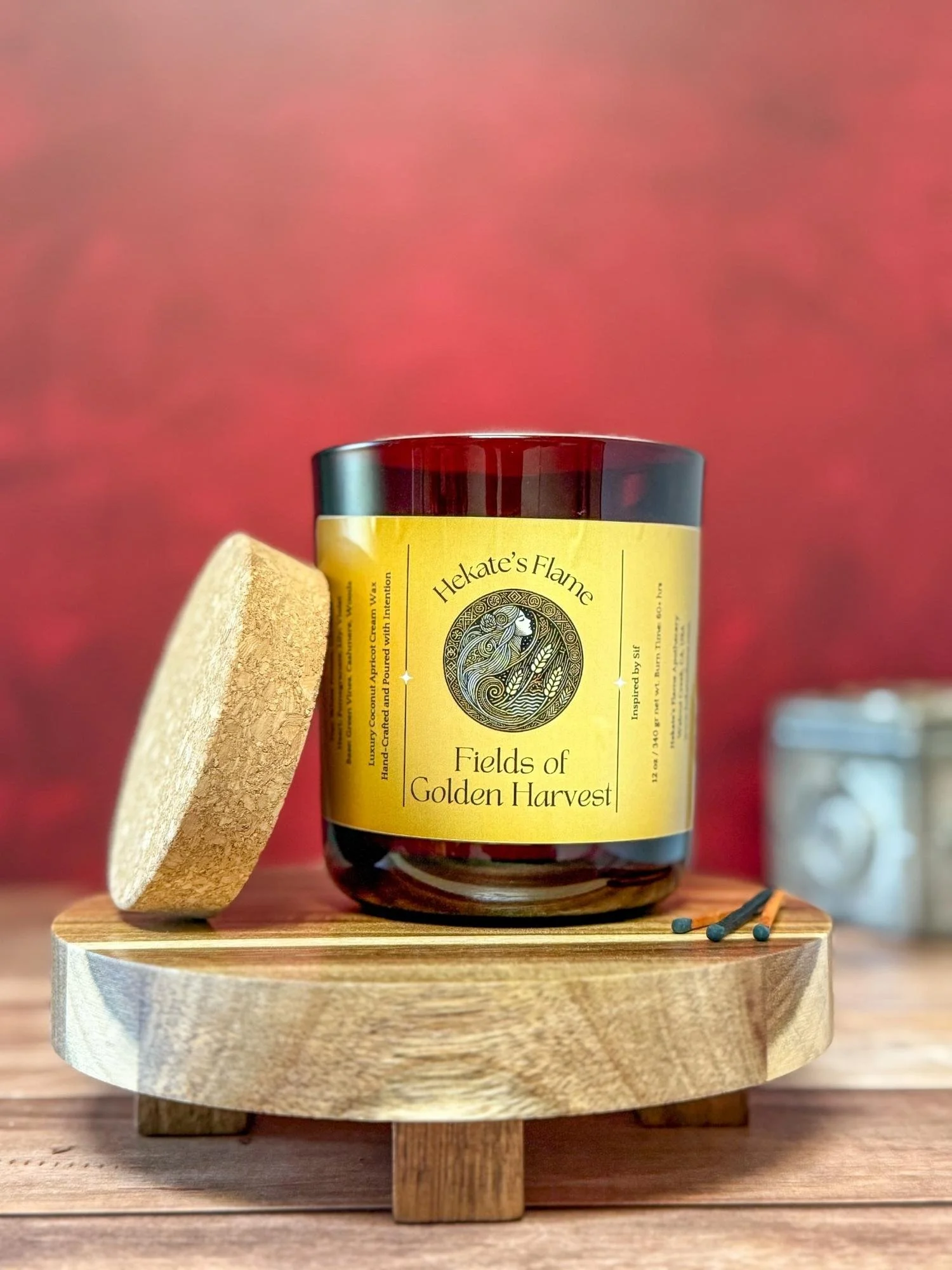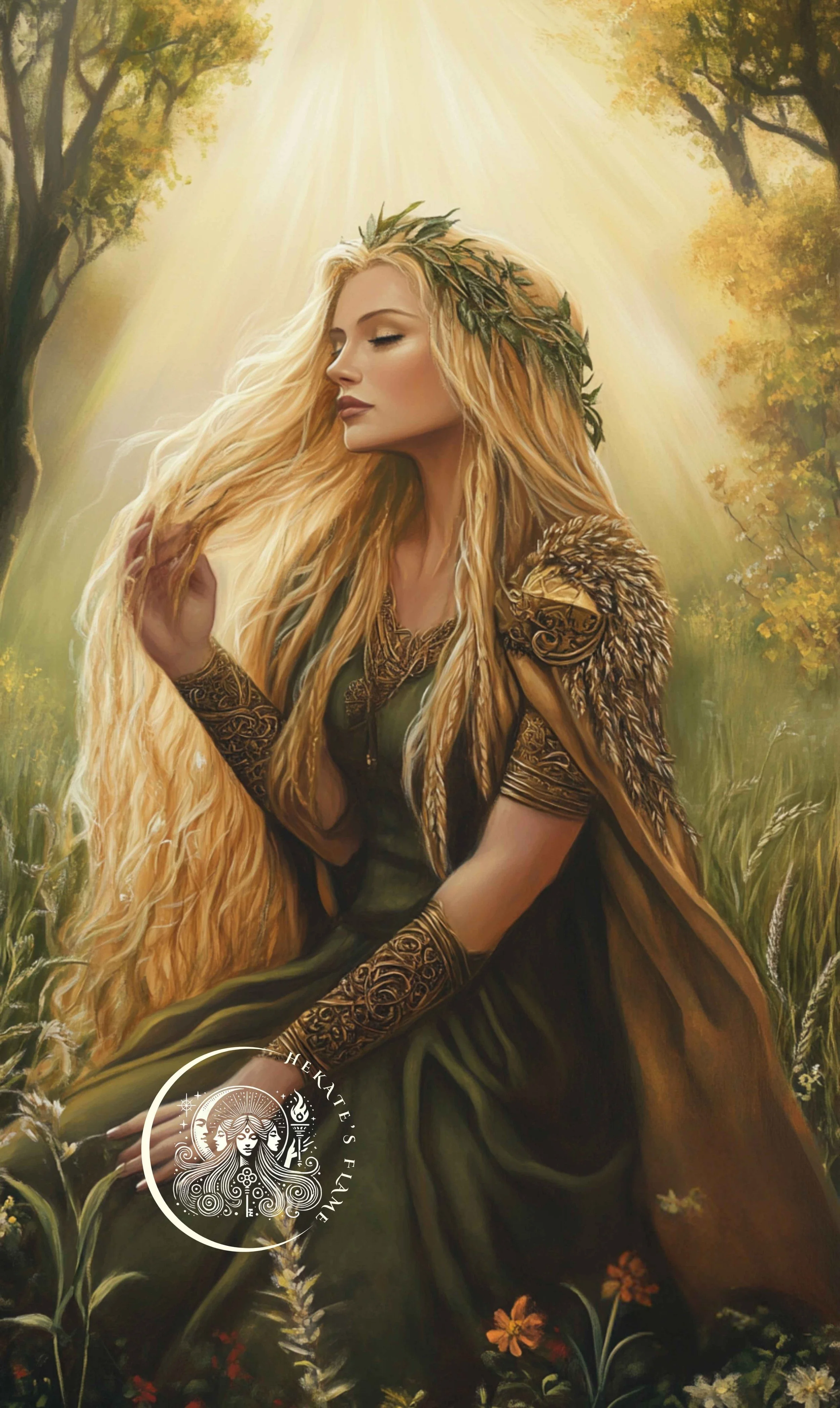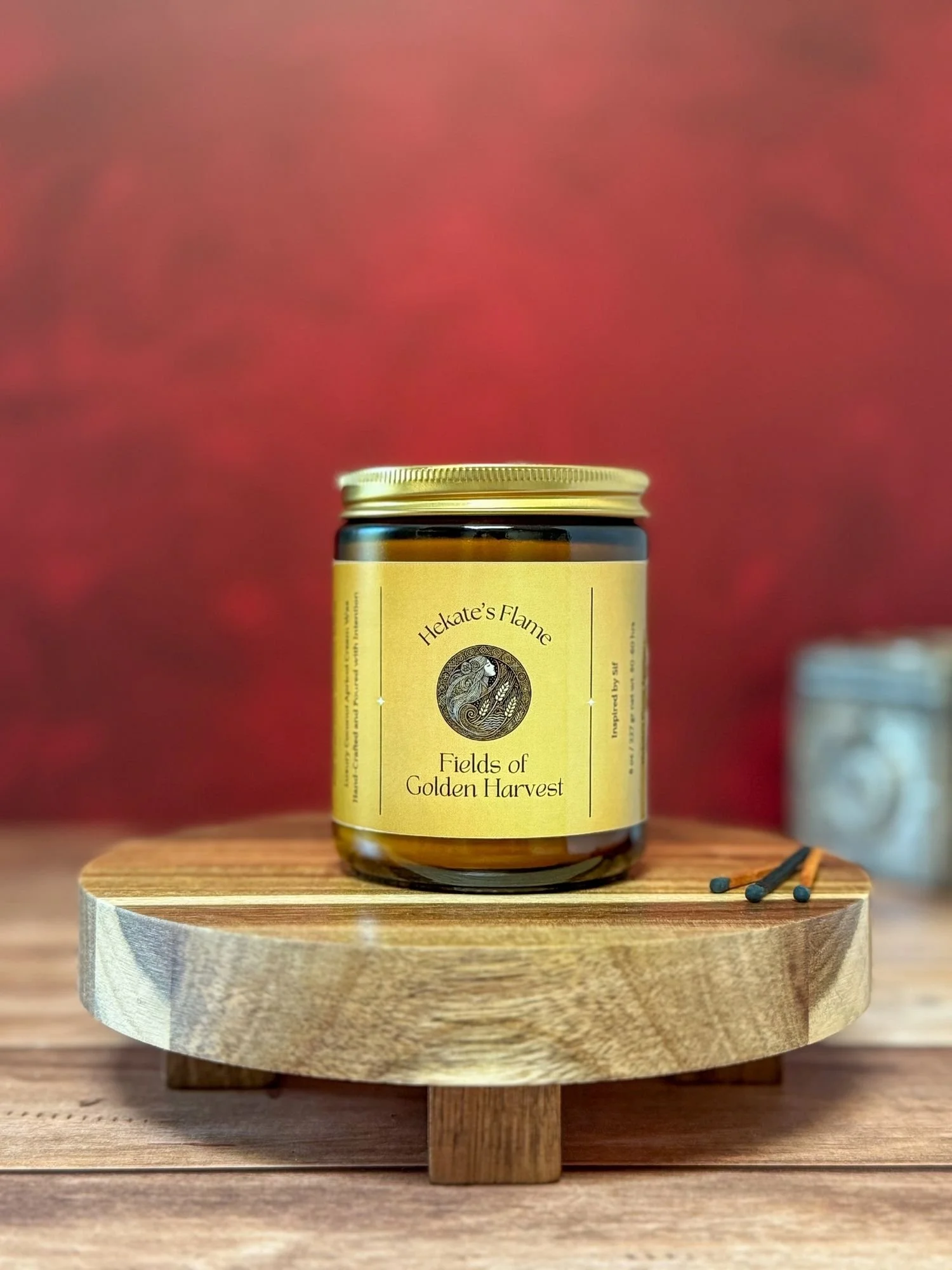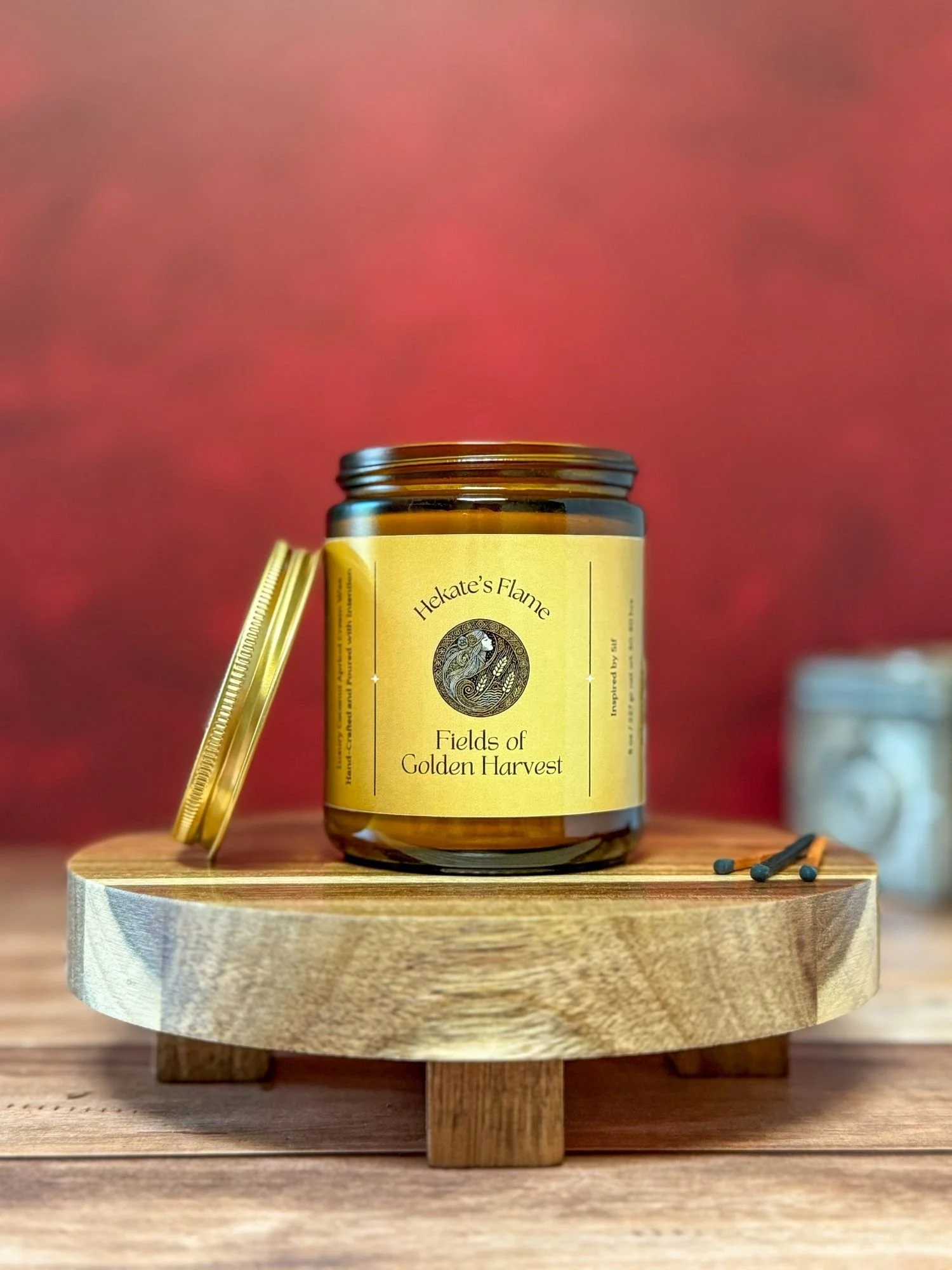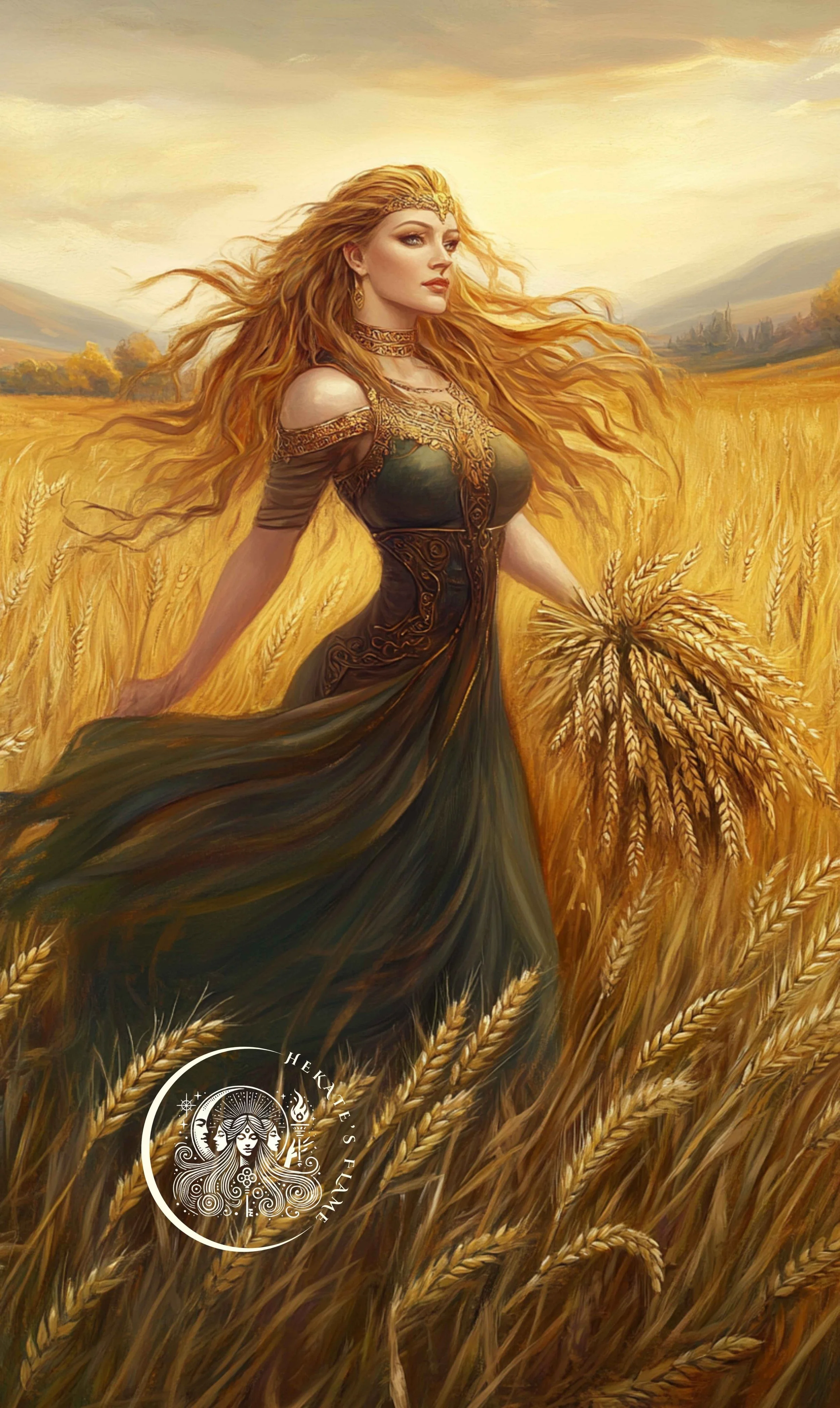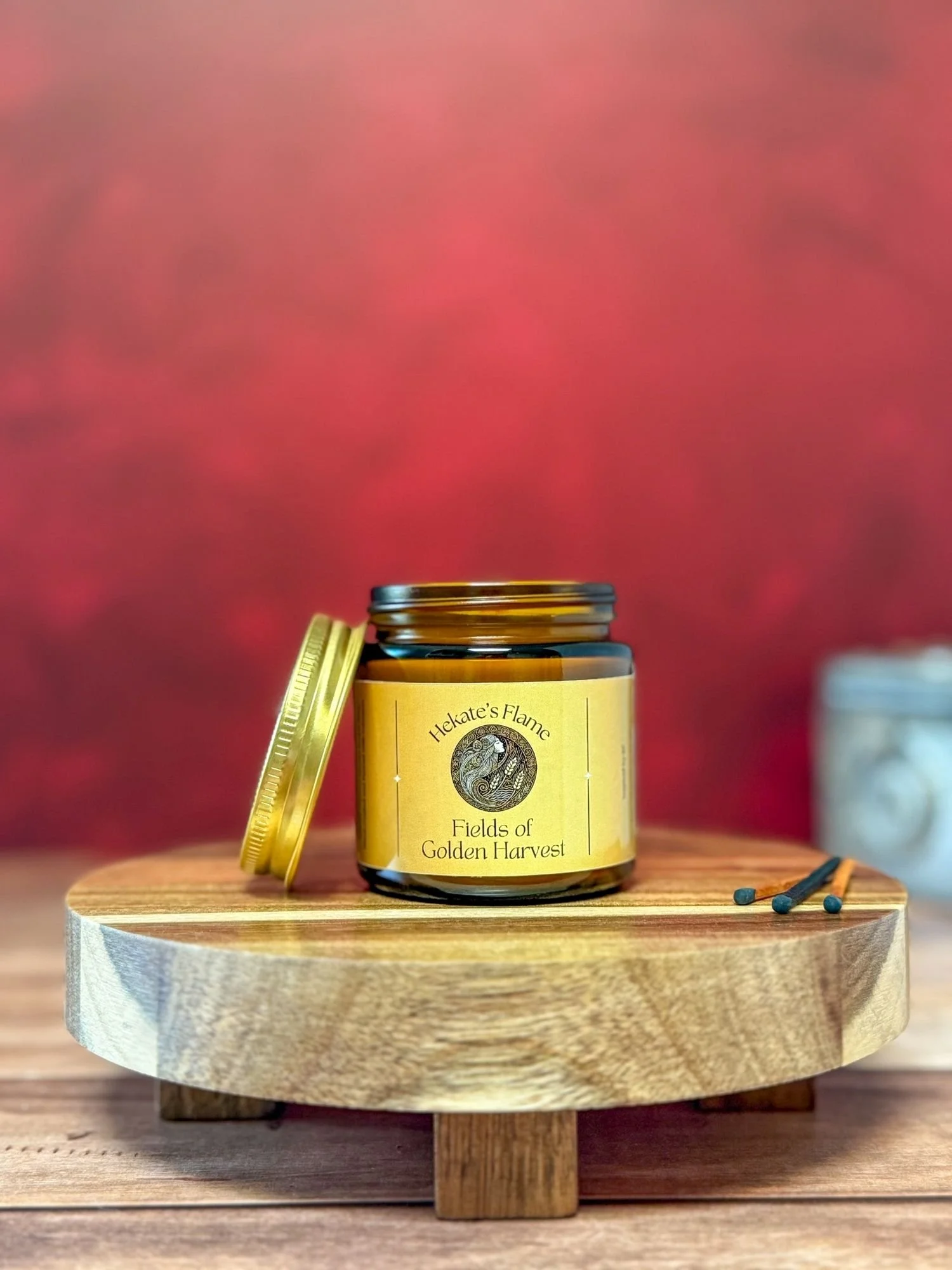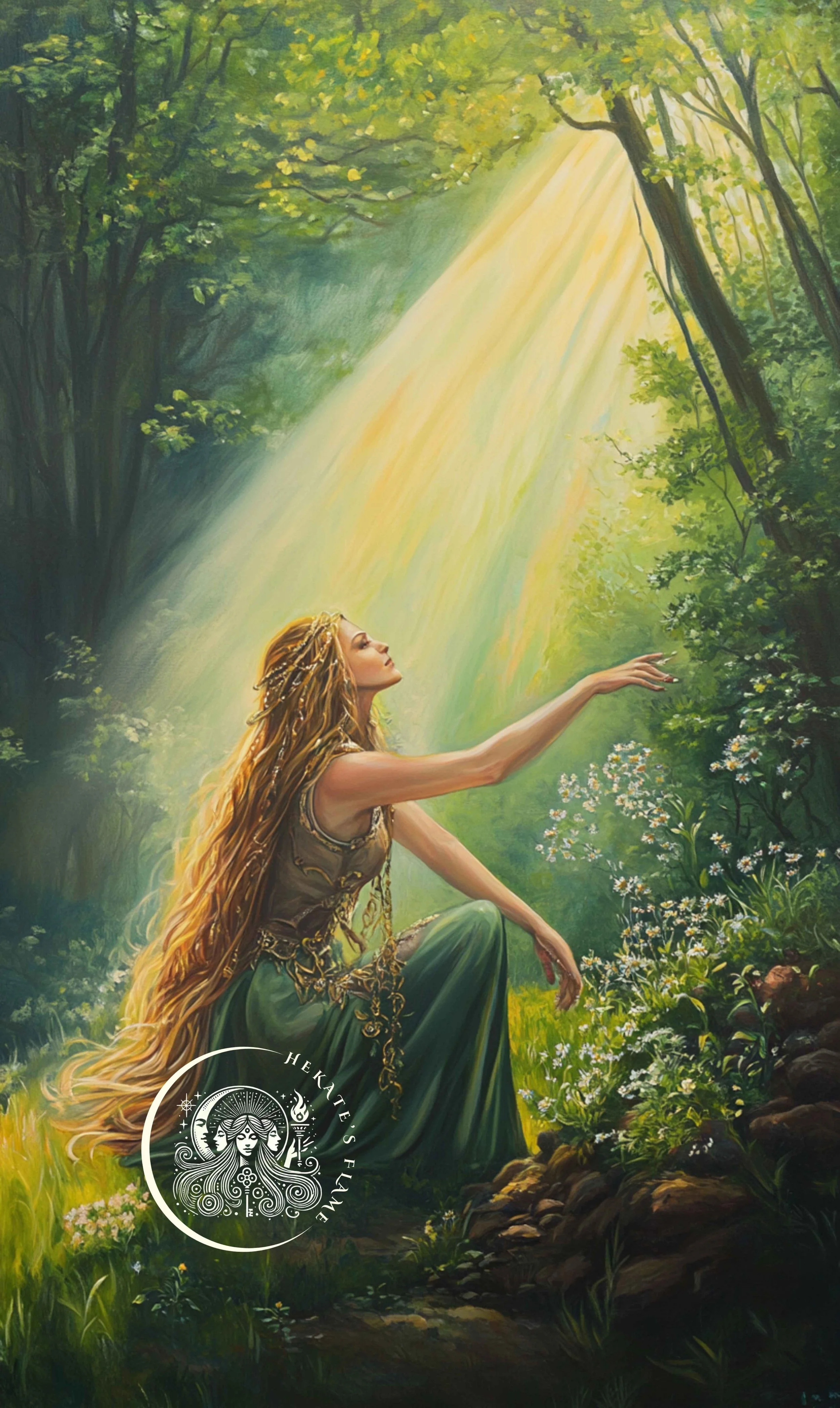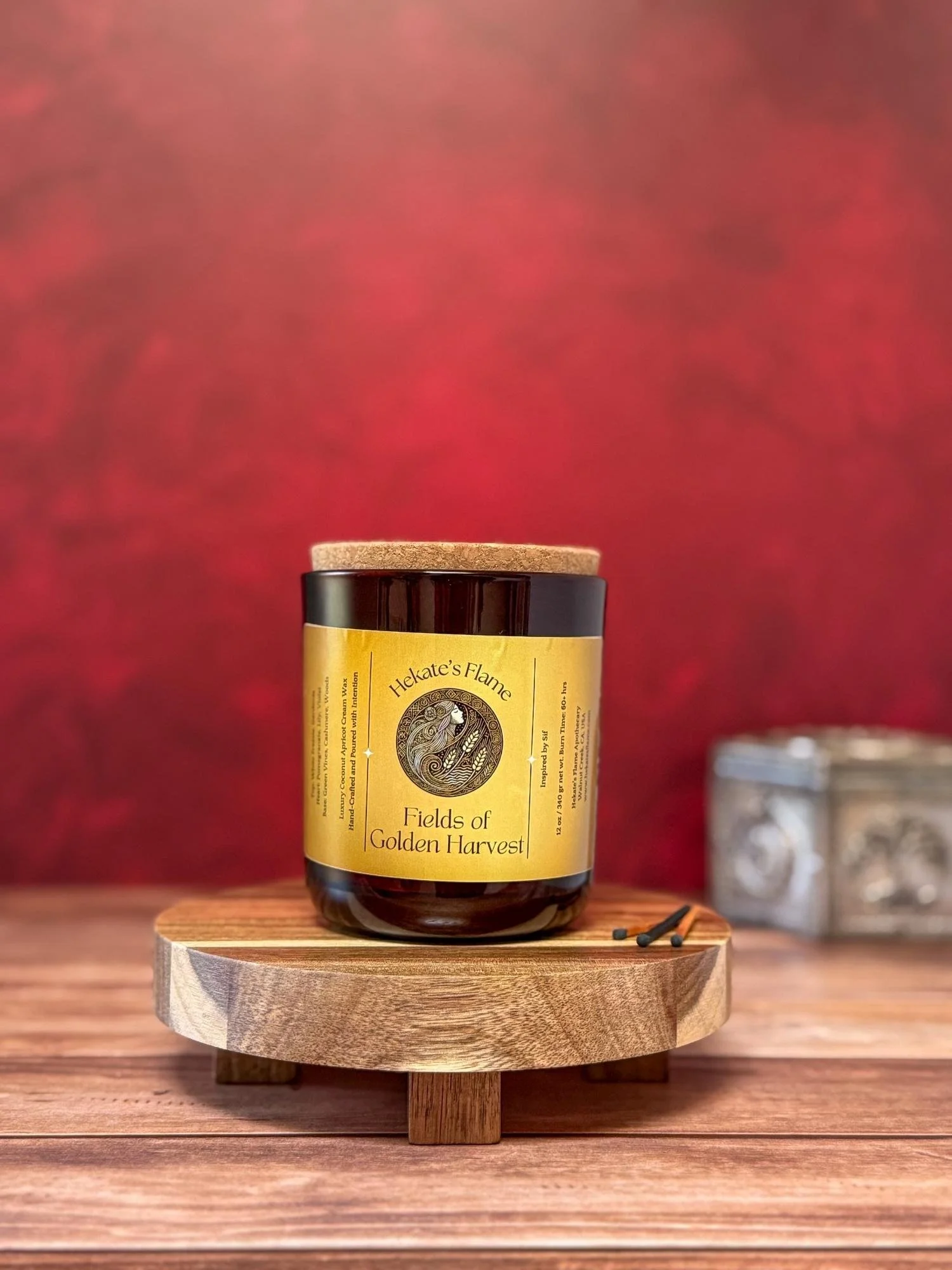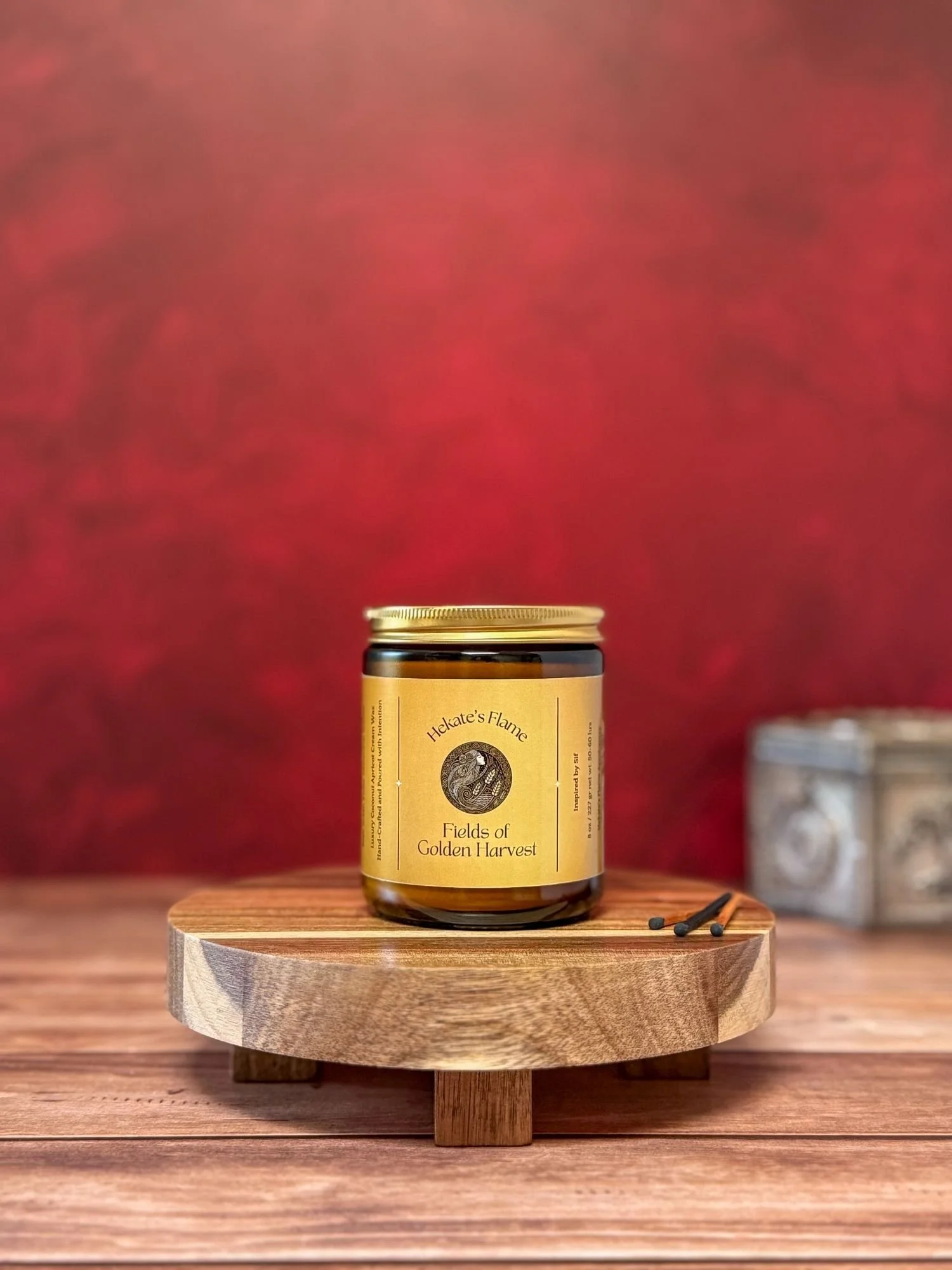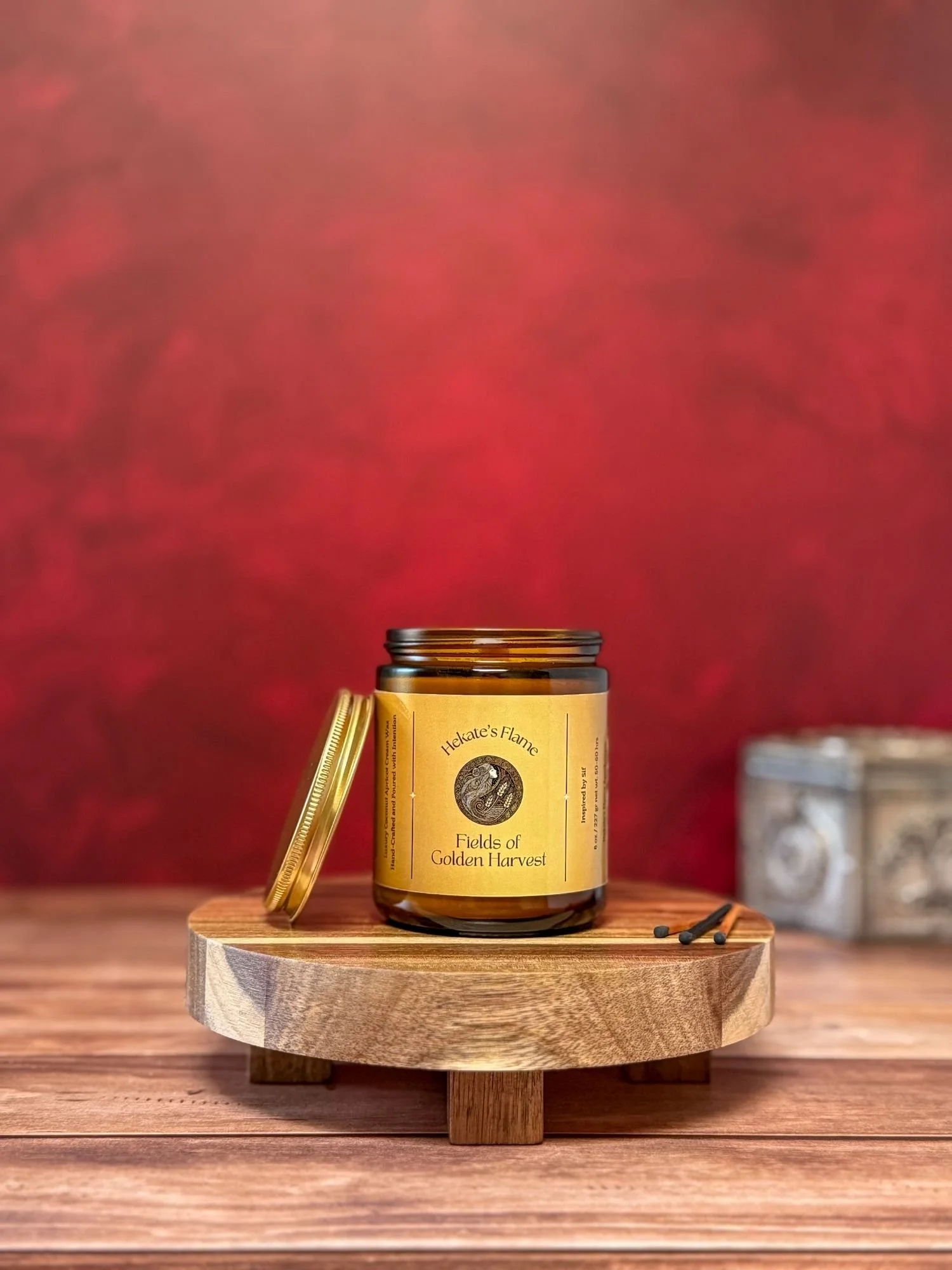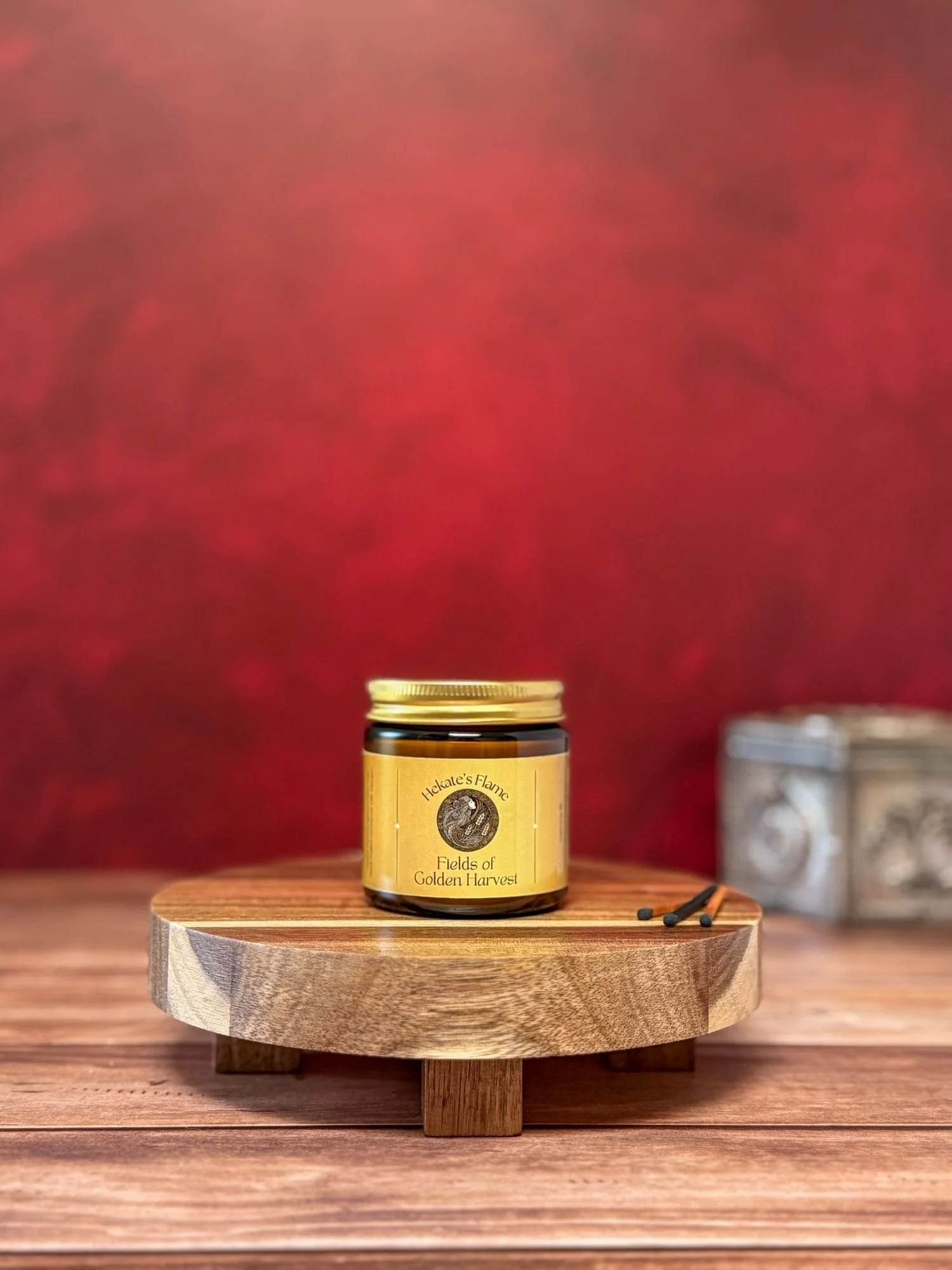‘Valhalla’s Grace’: a handmade artisanal candle inspired by Freyja, the Norse goddess of love, beauty, fertility, and battle
She who burns with battle fire and kisses the slain with honeyed steel
Imagine a sky streaked with gold and flame, the air alive with song and steel. That is the spirit of Valhalla’s Grace: jasmine and saffron bright as sunlight on armor, fir and cedar deep as forest and heart, and amberwood with ambergris glowing like fire through smoke. A scent of courage and desire, honoring Freyja, she who gathers the fallen, loves without fear, and burns with radiant power.
Scent Notes:
Top: Jasmine, Saffron.
Heart: Fir, Cedar.
Base: Amberwood, Ambergris.
❄️ Season Scent: Winter
🌲 Primary Scent Family: Woody & Earthy
🔥 Secondary Scent Family: Spicy & Warm
Please visit this blog post for more information on Scent Profiles, Top, Heart, and Base Notes.
Our candles are lovingly handcrafted in our home studio, Nimue’s Lair, nestled in Walnut Creek, CA. Each one begins with a luxurious blend of coconut-apricot wax, carefully infused with premium fragrance oils. Poured by hand into elegant glass vessels and amber jars, they’re finished with hand-cut labels and enchanted final touches. Every candle is a small ritual, infused with magick, intention, and the quiet glow of story.
-
12 oz Deluxe – Wine Red Aura Glass · Coco Apricot Wax
Burn Time: 60+ hours
Bold and enduring, this candle fills your space with myth and memory. Crafted for spacious sanctuaries, this candle shines in wide-open living rooms, high-ceilinged studios, and sacred hearths ~ places where scent is free to roam and the flame becomes a luminous companion to stillness and story.8 oz Classic – Amber Jar · Coco Apricot Wax
Burn Time: 50–60 hours
A perfect size for quiet corners and thoughtful pauses. Let it warm your reading nook, home office, or bedside altar, where its flame flickers like a whisper of intention.4 oz Petite – Amber Jar · Coco Apricot Wax
Burn Time: 20–25 hours
Small in size, rich in presence. This candle is ideal for travel, gifting, or sanctifying intimate spaces - guest rooms, personal altars, or quiet corners where scent and flame are invited to linger with intention. -
For detailed information about our waxes, wicks, fragrance blends, and vessels, please see our Ingredients & Materials Guide.
-
For guidance on how to tend your flame with care, ensuring the cleanest, safest, and most enchanting burn, please visit our Candle Care Guide.
-
Please visit the Shipping and Returns Information page for details.
-
All photographs, images, and written content on this website are original works of Hekate's Torch Apothecary, LLC (doing business as Hekate’s Flame Apothecary) and are protected by copyright. They may not be used, altered, shared, or reposted on any platform without explicit written consent. All label designs, photos, images, and content are the exclusive property of Hekate's Torch Apothecary, LLC.
For inquiries regarding the use of our content, please contact: care@hekatesflame.com
© 2025 Hekate's Torch Apothecary, LLC. All rights reserved.
Content Warning:
This post explores ancient myths that include themes of violence, including assault and warfare, which may be sensitive for some readers. Please proceed with care and be mindful of your well-being while engaging with these stories.
Freyja, the Divine "Lady" of Norse Mythology
In Norse mythology, Freyja is one of its most captivating figures, embodying love, beauty, magic, and war. Her name, Freyja, meaning "Lady," suggests a title rather than a given name, underscoring her elevated status among gods and humans alike. Though born to the Vanir, Freyja's influence extended into the Aesir following the truce that ended the Aesir-Vanir War. A goddess of unparalleled complexity, Freyja embodies a unique blend of archetypes shared across cultures: she is the lover, embracing sensuality and connection; the warrior, leading souls to her realm and fighting with valor; and the seer, channeling foresight and wisdom through her mastery of seidr.
These multifaceted roles have woven her deeply into the collective consciousness, positioning her as an enduring symbol of strength and autonomy. Freyja's presence transcends cultural boundaries, inspiring devotion across ages, with her persona marked by a balance of wisdom, passion, and fierce independence. As a beacon for those seeking resilience and self-mastery, Freyja's myth calls upon us to meet life's trials with courage, showing us that beauty, power, heart, and strength can thrive in harmony.
Freyja's Family and Origins: Vanir Roots and Connection to the Aesir
Born to Njord, the god of the sea, and possibly Nerthus, an ancient earth goddess, Freyja represents the powerful union of earth and sea. Alongside her brother Freyr, she embodies fertility, abundance, and prosperity.
As part of the peace agreement that bridged the divine realms, Freyja and Freyr became honorary members of the Aesir, symbolizing harmony between the realms and grounding their connection with both divine and natural elements.
Freyja's relationship with Freyr is as unique as it is symbolically rich. Some stories suggest a pure sibling bond, while others explore deeper, mystical connections. In one version, Freyr transforms into Hildisvini, Freyja's golden-bristled boar, allowing him to stay close to her during sacred rites and even on battlefields. Hildisvini's bristles gleamed with a brilliant, almost otherworldly light, emphasizing Freyja's dual nature of love and war, intimacy and protection. Together, Freyja and Freyr represent Norse ideals of unity and resilience, embodying an ethos that balances sensuality with sovereignty, weaving their fates inseparably into the fabric of Norse spirituality.
Freyja as the Lover, Warrior, and Weaver of Fate
Celebrated for her unapologetic embrace of love and beauty, Freyja's reputation echoes as far as the fields of Fólkvangr, her hall in the afterlife. Her allure was so intense that even the trickster god Loki couldn't resist stirring controversy.
He accused her of intimacy with numerous gods and elves, including her brother Freyr. Rather than diminishing her, these accusations reflect her autonomy and resistance to restrictive norms. Freyja symbolizes a feminine strength that not only claims but celebrates its freedom, marking her as the embodiment of unbridled passion.
Yet Freyja's sensuality is merely one facet of her formidable identity. As the leader of the Valkyries, Freyja selected half of the slain warriors from each battlefield to dwell in Fólkvangr. Known as Valfreya on the battlefield, she led her Valkyries with grace and rigor, ushering the bravest souls to her domain. Her dominion extended over love, life, and death, mirroring Odin's rule in Valhalla and illustrating her mastery of duality. Freyja's authority over both realms underscores her complexity, not confined to life alone but spanning the transformative cycle from birth to death.
Freyja's Prophetic Abilities and the Powerful Practice of Seidr in Norse Magic
Freyja was not merely a goddess; she was a völva, a practitioner of seidr, an ancient form of Norse magic that allowed her to influence fate and reveal hidden knowledge.
Her mastery over seidr granted her the ability to shape destiny, manipulate prosperity, and foresee events, including the ominous specter of Ragnarok, the final battle that would end the world. Freyja's vision of Ragnarok positioned her as a guide and guardian among the gods, giving her a unique understanding of the inevitable threads that bound their destinies.
Yet, by interpretive tradition, this foresight may have come with a heavy psychological toll. Freyja's insight into the inevitable fate awaiting the gods is imagined as a burden that only she could bear with grace, knowing the sorrow and loss that would come to pass. Even as she might hold this haunting knowledge, Freyja is seen as continuing to counsel and inspire others, embodying resilience that transcended mere strength. With each vision of their end, she could have reinforced her role as a guide and counselor to the gods, helping them accept and prepare as they approached their fated end. Her courage, in this interpretation, would allow her to instill in others a sense of dignity and wisdom, ensuring they would face Ragnarok with open eyes and unwavering resolve.
This prophetic gift, however, came with a shadow. Seidr was often viewed with suspicion due to its potent, ambiguous nature. While the gods revered Freyja's insight, they also feared the "dangerous" influence that seidr represented. The Aesir, ambivalent toward Freyja's knowledge, sometimes labeled her arts as "taboo" or even "evil." Yet their fear did not prevent them from seeking her teachings, a testament to her power that transcended conventional boundaries. Freyja's connection to seidr represents an embrace of nature's raw forces, positioning her as a bridge between life, death, and fate, a force beyond simple morality or convention.
The role of the völva in Norse society was similarly layered with reverence and caution. Like her earthly counterparts, Freyja traveled as a respected yet mysterious figure, offering wisdom in exchange for offerings, much as mortal völvas accepted food and lodging. Freyja's divine status elevated her above these mortal seeresses, but her role mirrored theirs, reflecting her unyielding commitment to prophecy and insight. She was a figure both feared and adored, her words as precious as they were unsettling to those who sought her guidance.
Her role as a völva extended beyond foreseeing Ragnarok; Freyja also used her skills to aid those who sought her guidance and protection. In one tale, she assists Ottar, a devoted follower eager to uncover his lineage, a quest of immense cultural significance in a world where lineage defined one's honor and place. Recognizing Ottar's deep need, Freyja transforms him into her sacred boar, Hildisvini, and accompanies him to a wise seeress. This transformation shielded him on his journey and symbolized his connection to Freyja, elevating him from a mere seeker to one carrying divine favor.
As her sacred companion, he could approach the mysteries of his ancestry with a sense of honor and courage, traits embodied by the boar in Norse culture. Through this act, Freyja reveals her compassion, using her gifts for herself and those she cares for, guiding Ottar toward a profound understanding of his heritage and purpose.
Freyja's practice of seidr thus encompassed both fierce knowledge and compassionate guardianship, positioning her as a goddess who defied simplification. She was neither bound by the conventional morality of the gods nor confined by tradition; she embodied a complex force of nature that danced between mystery and guidance, embodying strength and gentleness. Through seidr, Freyja became a living bridge between worlds, embodying the delicate balance of prophecy, compassion, and the mystical strength that continues to define her legacy.
Freyja's Love for Óðr and Her Unbreakable Devotion
The story of Freyja and her husband, Óðr, reveals a deep, tender side of the goddess. Óðr's name, meaning "ecstasy, inspiration, and fury," shares its linguistic root with Odin's title, Óðinn, hinting at a shared essence between the two. When Óðr left on long, distant journeys, Freyja's grief manifested as tears of amber and red gold, falling to earth and forming precious stones. These tears were said to glow softly with a warm light, symbolizing not just her sorrow but an enduring love that bridged realms. The legend of her tears has inspired countless stories and artworks over the centuries, most notably the golden, shimmering motifs of Gustav Klimt in the Art Nouveau movement, connecting Freyja's ancient myth to modern expressions of beauty and longing.
There is something profoundly human in the image of a woman so beautiful yet so mournful; her tears are not merely shed but transformed into precious gold, a poignant metaphor for the value of love and loss. We, too, have known the ache of separation, and her golden tears seem to reflect our collective sorrow, as though Freyja herself weeps on behalf of all hearts torn by absence. Her grief is not just sadness; it embodies enduring loyalty and strength, reminding us that love, when deeply felt, can transcend the physical and echo across ages.
In every drop, Freyja's tears represent an unbreakable devotion—a love so radiant it could only be made of gold. For those experiencing loss, her divine weeping provides a kind of solace, as though our pain, too, might be justified if it could take on the value of such a precious metal.
Perhaps that is why Freyja's myth resonates so deeply: she becomes the embodiment of love's resilience, elevating heartbreak into something beautiful, reminding us that even in our darkest grief, there is a radiance within. Freyja's tears thus remain an enduring symbol, a testament to a goddess who is both fiercely independent and deeply loving, speaking to the timeless, golden depths of love and sorrow.
The Brisingamen Necklace and Freyja's Tales of Desire
Perhaps one of the most iconic symbols associated with Freyja is her necklace, Brisingamen, a stunning piece crafted by four dwarves. So enchanted was Freyja by its beauty that she offered herself to each dwarf in turn to obtain it. Brisingamen's glow is said to rival the stars, casting a soft, golden light that mirrors the aurora borealis, shimmering with the mysterious beauty of the northern skies. More than mere ornamentation, this necklace is a radiant piece of the heavens woven into form, symbolizing her unbreakable nature, a celestial force as enduring as the stars themselves. It embodies her willingness to pursue her desires with unyielding dedication, capturing her beauty and resilience.
When Loki, the ever-deceptive trickster, stole Brisingamen, the necklace's profound significance was revealed through Freyja's heartache at its loss. Sensing her sorrow, Heimdall, the vigilant watchman of the gods, took it upon himself to retrieve the treasured necklace. He pursued Loki to the depths of the ocean, where both transformed into sleek seals, their bodies gliding silently through the dark, murky waters. In this shadowy realm, an eerie, muted silence set the stage for their primal contest. Twisting and darting with fluid grace and ferocity, Loki and Heimdall fought for control of the radiant Brisingamen, which pulsed like a fallen star between them, glowing with a mysterious light.
The necklace seemed to embody Freyja's own essence, radiating an unyielding will and defiance, as if the northern lights themselves were submerged, resisting Loki's grasp and longing to return to its rightful owner.
Every lunge, every turn heightened the tension, each god desperate to control the radiant necklace that seemed to carry the boundless force of Freyja's spirit.
The quiet clash between Loki and Heimdall, their slick forms silhouetted in the shadowy water, became a deadly dance, an aquatic duel that ebbed and flowed with unspoken ferocity. At last, with a swift, decisive move, Heimdall wrenched Brisingamen free from Loki's grip, and the triumphant watchman emerged from the depths, the light of the necklace once more embodying the unbreakable spirit of its rightful owner.
When Brisingamen was returned to Freyja, it reclaimed its place upon her as a testament to her indomitable will, forever intertwined with her identity as a goddess who pursues and protects what she values most. In its soft, golden glow, Brisingamen reflects not only her allure but also her fierce loyalty and strength, a symbol of a goddess whose desires, once claimed, could never be taken without a battle, shining as bright and unyielding as the stars above.
Parallels between Freyja and Goddesses like Isis and Aphrodite
Across ancient cultures, Freyja's spirit finds echoes in goddesses such as the Egyptian Isis and the Greek Aphrodite. Like Isis, Freyja combines wisdom with uncompromising independence, serving as a nurturer and protector. Aphrodite, goddess of love and beauty, similarly embodies the duality of sensuality and power, creating a mirror to Freyja's own attributes. These parallels reveal an archetype of feminine strength that transcends cultural boundaries, connecting Freyja to a lineage of goddesses celebrated for their wisdom, allure, and resilience.
Yet, while Freyja shares universal qualities with these figures, she is distinctly Norse in her complexity. Unlike Aphrodite, whose power centers on love and beauty, Freyja blends sensuality with a warrior's resolve. Her beauty is both a shield and a weapon, much like the icy fjords of Scandinavia, shimmering under the midnight sun, beautiful yet commanding respect, capable of overwhelming force. Similarly, while Isis represents mystery and magic, Freyja's magic is rooted in the wild, rugged landscape of the North, a seeress whose powers echo the raw, untamed elements of the Norse world.
These contrasts ground Freyja in the Norse ethos, where beauty coexists with resilience and wisdom with fierce independence. Her role within Norse tales aligns her with a universal archetype, a goddess who embodies courage, sensuality, and an unapologetic embrace of life's mysteries. Freyja's legacy is thus enriched by these comparisons while remaining firmly connected to her origins as a Norse goddess who balances the dual realms of love and war, life and death, beauty and power.
The Marriage Bargains of Freyja and Her Fierce Autonomy
Freyja's desirability often made her the object of pursuit among gods and giants alike, yet her spirit was a force not easily claimed. In one famous tale, the giant Thrym, overcome by his desire, brazenly stole Thor's mighty hammer, Mjölnir, and held it ransom, demanding Freyja's hand in marriage as his price. When this proposition was brought to Freyja, her reaction was a storm of fiery indignation, her refusal as swift and unyielding as the northern winds. This left Thor and Loki to devise a clever, if slightly absurd, ruse: Thor would don the bridal attire of the goddess herself, cloaking his fierce frame in delicate wedding garments to impersonate Freyja and deceive the lovestruck giant.
In Thrym's halls, draped in wedding finery and veiled mystery, the burly Thor posed as Freyja, his glowering presence barely concealed beneath the bridal guise. Thrym, oblivious to the deception, lavished "Freyja" with gifts, each one received with Thor's barely contained fury. At the moment of truth, Thor seized Mjölnir and revealed his true identity, humbling the giant with force as thunderous as his laughter.
This humorous tale is a testament to Freyja's fierce autonomy; she was neither prize nor possession to be bartered, her spirit untamed, and her will as immovable as the stars. No matter the guise taken to fulfill the ruse, the story reminds us that Freyja could never truly be contained or constrained by any bargain.
Freyja, Frigg, and Overlapping Archetypes in Norse Mythology
Norse mythology often intertwines Freyja with Frigg, Odin's wife, suggesting that the two may once have been a single goddess figure. Both embody love, fate, and foresight linked to wandering husbands. While Freyja's tears of amber mark her love for Óðr, Frigg remains similarly devoted to Odin, even in his absences.
The linguistic roots of their names, "Freyja," meaning "Lady," and "Frigg," meaning "Beloved," further hint at a shared Proto-Germanic origin that later evolved into distinct figures in Norse mythology. This connection is reinforced through their associations with bird-of-prey feathers, which both goddesses use for shapeshifting, underscoring their command over the skies and symbolizing the freedom and mystery in their characters.
In addition, Freyja's role as a völva (seeress) with mastery of seidr, a magic practice that allows one to influence fate, aligns with Frigg's less explicit but still potent association with prophecy.
Frigg is also said to have foreseen the death of her son Baldr, an act that mirrors Freyja's foresight and deep connection to destiny. Both goddesses wield influence over the weaving of fate, often depicted in medieval Scandinavian art as spinners of the threads of destiny. This weaving imagery solidifies their archetypal roles as caretakers of cosmic order and personal fate.
Scholar Hilda Ellis Davidson suggests that the goddesses may reflect ancient beliefs in a "Mother Goddess" who ruled both love and death. Freyja, with her ties to the Valkyries and her realm of Fólkvangr, embodies a goddess who governs both the living and the dead. Frigg, on the other hand, is often linked to home, marriage, and the guardianship of family, suggesting that while Freyja occupies a more active, warrior-like stance, Frigg represents the nurturing yet powerful aspect of a divine mother.
Together, Freyja and Frigg enrich Norse mythology, presenting a layered portrayal of love, wisdom, and destiny. They illustrate how feminine power is multifaceted, blending the fierce independence of Freyja with the steadfast loyalty of Frigg, thereby creating a comprehensive archetype that embodies the resilient, mysterious, and nurturing dimensions of divine femininity in the Norse pantheon.
Symbols of Freyja: Sacred Animals and Traditional Offerings
Freyja's symbols reflect her roles as both nurturer and warrior. Her chariot, drawn by two large cats gifted by Thor, embodies her independence and gentle spirit, while her sacred boar, Hildisvini, accompanies her into battle, representing fierce protection. Her cloak of falcon feathers grants her freedom of flight, symbolizing her boundless spirit and mystical allure.
Offerings to Freyja include honey, mead, flowers, and songs ~ gestures that honor her gentle love and courageous strength. Feeding stray cats in her name remains a traditional act, symbolizing her nurturing connection to the animal kingdom. These offerings celebrate her multifaceted nature, a goddess who encompasses gentleness and unyielding power alike.
Freyja's Timeless Legacy: Empowerment, Balance, and Self-Acceptance in Norse Mythology
Freyja's legacy as a goddess of empowerment and complexity has endured well beyond the Viking Age. In modern Paganism and Norse revivalism, she represents autonomy, mysticism, and fierce loyalty, embodying a powerful blend of love, wisdom, and independence. Freyja's myth speaks to the timeless theme of balanced strength, one that encompasses the compassionate and the formidable, a strength rooted in self-acceptance and the courageous pursuit of one's desires.
Today, Freyja continues to captivate and inspire, affirming the interconnected power of love, courage, and wisdom. Her legacy resonates profoundly in a modern world still striving to balance power with grace, reminding us that true strength lies in embracing all facets of the self: the nurturing, the fierce, and the mystical. Her myth reflects a vision of femininity that is unapologetically expansive, celebrating a divinity where beauty and power coexist without compromise.
For those who look to mythological figures for resilience and growth, Freyja's story offers a guiding light, an ancient example of empowered selfhood that continues to inspire personal transformation. Her enduring presence in contemporary spirituality serves as a reminder that harmony within oneself is not found by denying any part but by honoring every aspect - warrior, lover, seer, and sovereign - within. In calling on Freyja, many find strength and the courage to face life's challenges with a fierce, open-hearted embrace of their whole selves, a testament to her timeless power and relevance.
References:
Cavendish, R. (1970). Man, myth and magic: an illustrated encyclopedia of the supernatural. Marshall Cavendish Corporation.
Illes, J. (2010). Encyclopedia of spirits: The ultimate guide to the magic of fairies, genies, demons, ghosts, gods & goddesses. Harper Collins.
Littleton, C. S. (2002). Mythology: the illustrated anthology of world myth & storytelling. Duncan Baird.
McCoy, D. (n.d.). Freya. Norse Mythology for Smart People. https://norse-mythology.org/gods-and-creatures/the-vanir-gods-and-goddesses/freya/
McCoy, D. (2016). The Viking spirit: An introduction to Norse mythology and religion. CreateSpace Independent Publishing Platform.
But Freyja is the most renowned of the goddesses; she has in heaven the dwelling called Fólkvangr, and wheresoever she rides to the strife, she has one-half of the kill, and Odin half, as is here said:
Fólkvangr it is called,
where Freyja rules
Degrees of seats in the hall;
Half the kill she keepeth each day,
And half Odin hath.



